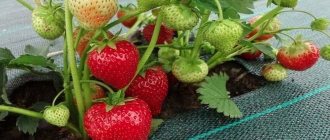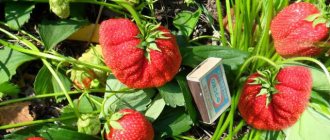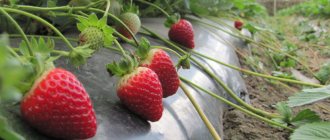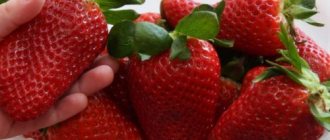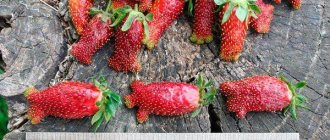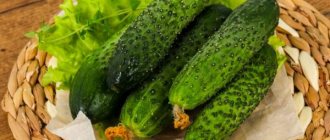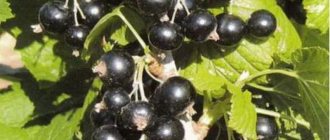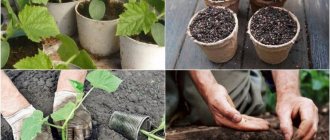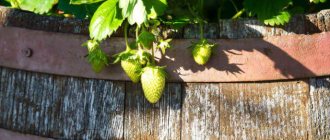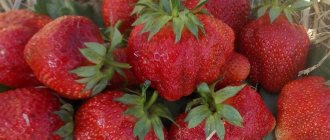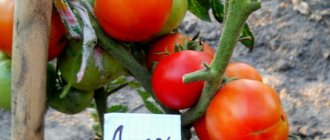History of selection
Honey is a variety of table strawberry. This plant is usually understood as the Honey variety, bred by American breeders. Despite the fact that the hybrid is characterized by a high content of sugars in the pulp, it received its name due to the place where it was bred. It became the provincial American town of Honeoye (abbr. - Hone), where in 1979, by crossing the local varieties Vibrant and Holiday, this highly productive plant was born.
On the territory of Russia and neighboring countries, the hybrid was regionalized relatively recently. The plant was included in the register of safe and productive varieties of fruit crops only in 2013. The best territory for cultivation is considered to be the North Caucasus zone, as well as the central regions with a temperate climate.
Description and characteristics of the variety
Honey strawberry is one of the best representatives of modern selection. The hybrid has not only individual yield indicators, but also morphology. Thanks to this, breeders managed to obtain a truly unique and productive plant, distinguished by a special shape and type of development.
Did you know? The official year of birth of strawberries is considered to be 1766. At this time, spontaneous pollination of several varieties of strawberries occurred in the collection of plants of the French botanist Antoine Duchesne, which led to the appearance of large and fleshy berries in the plants.
Bushes
The hybrid is distinguished by rather tall and large bushes, with strong and straight shoots, covered with a large number of leaves. The leaf blade of the plant is medium-sized, trifoliate, of complex shape. The leaves are located on elongated petioles no less than 10 cm long. The petioles have slight pubescence, which is a characteristic feature of the variety. During flowering, the stem is covered with numerous flowers, up to 3 cm in diameter. Each plant can have about 10–15 delicate white flowers, which are united into a small corymbose-type inflorescence.
Video: Strawberry Honey
Fruit
The fruits of the variety have a complex structure; they are a multi-nut berry formed from an overgrown receptacle. The shape of the fruit is characteristic, cylindrical-conical. The color of the peel is deep red, with a glossy sheen, the flesh when cut is a delicate red-pink hue.
It is characterized by moderate juiciness, increased sweetness, and light sourness. The density of the pulp is uniform, there are no cavities inside the fruit. A special property of the variety is that the aroma of the berries increases as generations change, so the latter fruits are considered especially valuable and have a richer taste.
Remontant strawberry variety Honey Summer
At the height of summer, some strawberry varieties have already finished bearing fruit, while others continue to bear fruit. But gardeners who love to grow sweet berries are already thinking about what other strawberries to choose to plant. On the eve of August, from the existing variety of varieties, Honey Summer is of interest.
Description of strawberry variety Honey Summer
This remontant large-fruited strawberry was bred in Russia and declared as a new product. It delights gardeners with its weighty, sugary berries of an unusual red color with an orange tint.
Ripe juicy berries have an elongated heart-shaped shape. They are mostly large and larger than average in size. There is no void or visible core inside the pulp.
Having a very sweet taste, the berry has a bright strawberry aroma. Compared to other varieties, it benefits from transportation. Transportation without changing quality is ensured due to the dense structure of the pulp. When stored in the freezer and defrosted, it does not lose its shape.
Features of the variety
Honey Summer is a day-neutral variety that is characterized by:
- Repeated fruiting. The repairman gives away the harvest twice (in June, August), showing the friendly ripening of the berries. In autumn, fruits also form on the bushes, but poorly.
- The yield of leveled fruits is about 900 g per bush. This indicator does not depend on their number on the peduncle.
- Ripening at very early stages. The new variety forms spreading bushes that produce long tendrils (40-45 cm), thick leaves and drooping flowering stems.
- The need for free space for growth and abundant watering.
Located on a support in the form of a cascade, the vines with mustaches give the plant a decorative appearance and decorate the bed like hanging crops.
Agricultural technology varieties
In order for the Honey Summer to fully show its advantages, it needs proper care. The variety can be cultivated in different ways:
- on ordinary beds;
- using frames, vertical and horizontal suspension systems;
- in PVC pipes, pots and flowerpots, bags, plastic bottles;
- on greenhouse racks and greenhouses;
- on the loggia.
Each plant requires a lot of free space on the site.
For its normal development, from 0.7 to 1 square meter is allocated. m of land, loosened several weeks before planting, incorporating humus or other types of organic matter into the soil. Make sure not to bury the rosettes of plants and not plant them too shallow.
If agricultural technology is organized correctly, then the first berries can be tasted at the beginning of summer. Care is carried out in accordance with the general rules that are followed when caring for strawberry beds: the soil is loosened and mulched, treated against diseases and pests. In winter, the ridges are protected from frost using any covering material.
One of the main conditions for the successful cultivation of the Honey Summer variety remains watering and fertilizing. It needs to be done every week. To prevent the plants from becoming depleted, the mustache is trimmed in time.
Breeding the Honey Summer variety
If the area for perennials needs to be increased, it makes sense to leave the mother bushes. The harvest from them will be meager: their task is to provide planting material. To keep the mustache strong, the peduncles are removed.
Advice! On each lash with located tendrils, only the first, strongest rosette is left for rooting; all subsequent ones are cut off with scissors.
To obtain a larger quantity of perennials, the strawberry bush is divided into rosettes or seeds are collected. In early spring they are germinated, the seedlings are watered and fed.
If there are 2 true leaves, it is planted in a container and then planted in a permanent place. By this time, 6 leaves should form on the seedlings.
Honey summer requires attention and proper care. But the costs of growing are offset by the pleasure gained from harvesting. For those who like to experiment with a new variety, such work is a joy.
Selecting the best seedlings for planting
Today there are many producers and home breeders of strawberry seedlings, so the market is overflowing with an abundance of seedlings. The strawberry variety Honey is no exception, however, planting material is often characterized by low rooting activity. This is due to the fact that the plants were bred with serious errors or were not stored properly, which often leads to a deterioration in their activity and even death.
To avoid this, when purchasing, you should pay attention to seedlings that must have:
- thick leaves, with a rich green color, without any spots or other pathologies;
- at least 3-4 full pages;
- dense horn, at least 7 mm thick;
- a well-developed root system (at least 7–8 cm long), without foci of putrefaction or any other pathologies.
It is imperative to choose the right place of sale. Healthy and high-quality seedlings are almost always found in specialized stores operating under a license from professional nurseries. Homemade seedlings do not always meet varietal standards, as well as the required viability . In addition, such plants should be discarded because they are often infected with all kinds of fungi and pest larvae.
How to feed the variety
When choosing a feeding technique, you must remember that for the Medovaya variety, both complex organic and mineral types of fertilizers are important. Mineral supplements for strawberries can be purchased at a specialty store. Honey strawberries require adherence to exact proportions when applying mineral fertilizers, which are written on the package.
In order to accurately calculate the required amount of fertilizer for the Honey variety, you need to take into account the composition of the soil. If there is an excess of chemical compounds, you can burn the foliage and roots of the strawberry. If mineral fertilizers have been used for too long, then you should switch to organic fertilizers gradually. With proper selection of soil, Honey will receive more minerals from the soil. The best organic fertilizers are ash and chicken manure.
Using these tips, you can get a high-quality harvest of the popular strawberry variety.
Strawberry Honey Summer is a large-fruited hybrid with a very good yield and a long fruiting period. We will tell you about the characteristics and qualities of the variety, consider how Strawberry Honey Taste F1 differs from it, and also share reviews from gardeners about these hybrids.
Step-by-step planting technology
Strawberry seedlings are planted in early spring (late April) or early autumn (first half of September). Autumn planting is considered the most acceptable, since it allows you to get the first fruits next spring, while with spring planting this will take more than 1 year. Strawberries are planted according to the standard pattern. To do this you need:
- carefully level the previously dug area and remove all pollutants, weed residues, etc. from the soil;
- mark parallel rows on the soil, with row spacing of about 50 cm;
- in each row, at a distance of 30 cm, make small indentations (10x10 cm);
- place a plant in each hole, and then tightly cover its root system with soil;
- thoroughly water the plantings with settled water heated to +18...+20°C.
Reproduction
Garden strawberries reproduce in the same way as other representatives of the crop:
- seeds;
- mustache;
- dividing the root.
For beginner gardeners, the first method is not suitable, since the seeds germinate slowly. As a rule, they “sit” in the nursery for a month, or even two. Strawberry seeds of this variety are sold in many agricultural companies, for example, Siberian Garden, Gardens of Russia.
Strawberry seedlings
- Seeds are sown at the end of winter, in February and March. The soil should be loose, nutritious and breathable. When compiling the soil yourself, be sure to add sand. Before planting, the soil is disinfected with Fitosporin or a hot solution of potassium permanganate.
- Strawberry seeds are not buried, but distributed over the surface of the soil. An experienced gardener talks about how to sow strawberry seeds with snow stratification:
- The containers must be covered with glass or film and placed on a warm, well-lit window.
- When the first sprouts appear, the film is not removed, but slightly opened so that the greenhouse effect remains inside.
- Seedlings dive when 1-2 leaves appear. Subsequently, the plantings are carefully watered and fed with special fertilizers or organic matter. Seedlings with 5-6 leaves are planted in the ground.
Features of care
Like any fruit crop, honey strawberries require appropriate care for good growth and long-term fruiting. The procedure provides for a special regime of watering and fertilizing, soil treatment and preventive spraying with protective equipment. This allows you to create a favorable microclimate that stimulates the productivity of the beds.
Video: How to properly care for strawberries in spring, summer and autumn
Watering, loosening
Periodic moistening of the beds is the key to a high-quality strawberry harvest. Without this, the berries will acquire a less rich taste, and will also lose their juiciness and characteristic aroma.
It is best to use drip irrigation for moisturizing , calculating about 1–2 liters of liquid/bush/day. In its absence, you can use root irrigation, as well as row-spacing irrigation. In this case, the water consumption should be about 10 l/1 m², and the frequency of the procedure should be once every 3 weeks. During particularly hot periods, the number of waterings can be increased, up to 3-4 procedures per week.
Find out more about how often and correctly to water strawberries.
Loosening is considered a mandatory procedure that follows watering. It is performed 1–2 days after watering the beds, or at least once a week. This makes it possible to saturate the soil with oxygen, as well as eliminate weeds, the development of which often inhibits plant growth and the formation of berries.
Since strawberry roots are in the upper layers of the soil, loosen the soil carefully, to a depth of no more than 5–7 cm.
Top dressing
Fertilizing is carried out from the second year after planting. With qualified preparation of the site after planting, right up to wintering, the plants do not need any additional elements, so the procedure begins only in the spring.
Important! It is best to apply fertilizing immediately before watering. This will improve the effectiveness of the procedure and also activate beneficial microflora in the substrate.
Fertilize at least 3 times per season, according to the following scheme:
- In mid-late April, plants are fed with a solution of cow manure (1:10) or nitroammophosphate (30 g/10 l of water). Fertilizing is given at the rate of 10 liters of working mixture per 1 m² of beds.
- During the period of budding and berry formation, plants should be given additional potassium. To do this, use a solution of chicken manure (1:15) or potassium nitrate (30 g/10 l of water). The feeding consumption should be about 10 l/1 m².
- The last feeding is carried out in late autumn, before preparing the plants for wintering. Strawberries are fertilized with a solution of nitroammophoska (30 g/10 l of water), at the rate of 10 l/1 m² of plantings.
Preventative treatment
Among gardeners, the Honey strawberry is considered a fairly resistant variety to fungi and pests, but despite this, it is necessary to carry out a number of preventive measures, which begin 2-3 weeks after planting and are carried out throughout the entire growing season.
Scheme of preventive treatments for strawberries against fungi and pests:
| Period | Diseases and pests | Drugs |
| Formation of buds | Powdery mildew, gray mold | "Alirin-B", "Fundazol", "Bayleton" |
| Leaf spot | "Horus", 1% Bordeaux mixture | |
| Before flowering | Gray rot, powdery mildew | "Alirin-B", "Fundazol", "Bayleton" |
| Leaf spot | "Horus", 1% Bordeaux mixture | |
| Spider mite | "PSK", "Kemifos", "Fufanon" | |
| After picking berries | Powdery mildew | "Topaz", "Alirin-B", "Fundazol" |
| Leaf spot | "Horus", 1% Bordeaux mixture | |
| Spider mite, weevil | "Aktellik", "Kemifos", "Novaktion" |
Preparing for cold weather
Young and adult plants are able to quite successfully withstand seasonal frosts under snow cover down to -20°C. In regions with colder winters or little snowfall, it will be necessary to prepare the bushes for the seasonal cold.
To do this, each individual bush should be mulched with sawdust, pine needles, coconut coir, seed husks, etc. In this case, the thickness of the mulch should be at least 10–15 cm. In their absence, you can use a special artificial canvas to cover the plant (spunbond). If strawberries have been grown on the site for more than one year, mature bushes can be pruned before wintering. This will make it possible to rejuvenate them, as well as enhance productivity.
We recommend reading in more detail on how to protect strawberries from frost.
Disease and pest control
If it was not possible to protect the beds from all kinds of pests and diseases, you should immediately resort to combating the problem. Neglecting the danger can lead to sudden wilting of plants and instant death of plantings in just 7–10 days.
With the development of all kinds of putrefactive foci, as well as other manifestations of fungal infections, the affected plants should be sprayed twice, with an interval of 2 weeks, with any complex fungicide based on copper-containing substances (Skor, Quadris, Amistar, etc.).
In case of insect pests, the beds should be sprayed with Actellik, Kemifos or Novaktion. This procedure is done 2 times, with an interval of 2 weeks, and in addition to the plants, the row spacing should also be sprayed.
Did you know? Strawberries are a natural aphrodisiac. Its berries contain a huge amount of zinc, which increases sexual desire and also significantly increases the likelihood of conception.
Disease and pest control measures
The Honey Summer variety is considered resistant to disease, but for the purpose of prevention or after an unsuccessful wintering, plants must be treated with copper sulfate or Bordeaux mixture. This mixture is very aggressive, so in early spring spraying with a 3% solution is allowed, but after green leaves appear, the concentration is reduced to 1%. In the fall, after harvesting and pruning foliage, the treatment is repeated. This method is considered the most effective, destroying up to 90% of wintering pests and pathogens.
Harvest and storage
Honey strawberries are harvested as the fruits ripen. This is done manually to avoid damage to the delicate berries, and each fruit must have a stalk. Neglect of these requirements contributes to a sharp decrease in the shelf life of the crop.
Store fruits in common plastic, wooden or paper containers covered with natural fabric. The optimal temperature for storing berries is within 0…+2°C. This makes it possible to maintain the freshness of the crop for 4 days after harvest. At room temperature, strawberries can be stored for no more than 24 hours.
To increase the shelf life of the crop, it is recommended to pick the fruits in their unripe phase, in which case they can be stored for up to 7–10 days. Frozen berries can be stored for about a year.
Honey strawberries are a real godsend for the household, because the plant pleases with ripe fruits for 3 weeks, and is also distinguished by a bountiful harvest. The hybrid does not require complex care, so generally accepted measures will be sufficient for its successful cultivation. In this case, special attention should be paid to fertilizing and watering strawberries, which will directly affect the quality of the harvest.
Strawberry Honey taste F1 - reviews from gardeners
These strawberries are great for growing for sale. Regularly shaped berries have good keeping quality and transportability. I have been growing it for 3 years and regularly get good harvests.
Igor, 35, Moscow
Strawberry harvest honey taste
I really like Strawberry Honey Flavor because of its pleasant aroma and taste. To ensure that it grows well, before planting, I harden the seedlings in a basement, unheated room for 1-3 days. I transfer it to open ground only when stable heat has been established, when the soil has warmed up to 12 degrees, and the risk of frost returning is minimal.
